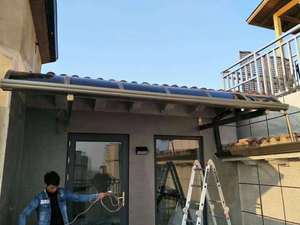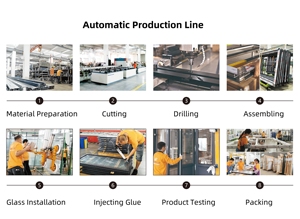(37299 products available)




















































































































































































Balcony canopies are structures that provide shade and shelter on balconies. They are usually made of strong materials like metal or wood and can be fixed or movable. They help create a comfortable outdoor space by offering protection from the sun, rain, and wind. They come in various types, each catering to different aesthetic and functional needs. They are as follows:
Fabric canopy
Fabric canopies for balconies are popular because they are light, flexible, and economical. They are made of strong fabrics like polyester or acrylic that can resist UV rays and weather conditions. Fabric canopies are available in many colors and styles, so they can match any balcony look. They can either be fixed or rolled up when not in use to give more freedom and convenience.
Retractable balcony awnings:
These canopies can be extended or retracted based on the needs. They provide shade when needed and can be easily put away to enjoy the sun. They are great for changing weather or personal taste. They are often made of durable fabrics like polyester or acrylic and come in various colors and patterns. Their retractable feature allows for easy adjustment and storage, making them ideal for both residential and commercial buildings.
Metal canopies:
Metal canopies are strong and long-lasting and need little maintenance. They are made of aluminum, steel, or wrought iron, which can withstand harsh weather and last long. Metal canopies are good for permanent shade and cover and add a classy and stylish look to the balcony. They come in solid designs or ones with intricate patterns to suit different tastes.
Wood canopies:
Wood canopies offer a natural and warm look, making them ideal for creating a rustic or natural theme. They are usually built with treated wood or hardwoods that can withstand outdoor conditions. Wooden canopies can be designed to integrate with other wooden balcony structures, providing a seamless and cohesive appearance. They may require more frequent maintenance than other materials to prevent warping, cracking, or pest infestation.
Polycarbonate canopies:
Polycarbonate canopies are clear or tinted and let in lots of light while blocking harmful UV rays. They are tough and shatterproof, making them safe and reliable. Polycarbonate canopies are great for protecting against rain and moderate wind while still enjoying natural light on the balcony. They can be fixed or used as a cover over outdoor furniture or areas where people gather.
Glass canopies:
Glass canopies provide a sleek, modern look and allow maximum natural light while offering a high level of protection against rain and snow. Tempered glass, known for its strength and safety, is typically used. Glass canopies are easy to clean and maintain and can be designed with various tinting and texturing options. They are often supported by a framework of stainless steel or other durable metals, providing a sophisticated and upscale appearance. While they are more expensive and require more structural support, glass canopies deliver elegance and clarity unmatched by other materials.
There are many designs of balcony canopies. So, balcony canopy design can be made in different ways. These are some of the popular designs of balcony canopies.
Retractable canopies:
These canopies can be extended or folded as needed. They use a foldable awning system with a few rods and a pulley mechanism. They are good for people who want a temporary balcony awning.
Extendable canopies:
The extendable ones have a few sections. They are pulled out and folded using a single mechanism. They are good for people who want a minimalistic and modern canopy design.
Fixed canopies:
These canopies are built into the house structure and do not move. They are made using metal, wood, or concrete. They also come in many shapes, such as arches, sloped roofs, and domes. They are good for people who want a stable and permanent structure on their balcony.
Retractable awnings:
These can be rolled in and out using a remote control or manual crank. They are made of fabric or vinyl and supported by metal frames. They are good for people who want a stylish and modern canopy.
Tensioned canopies:
These canopies use tensioned wires or rods to hold the fabric tight and flat. They look sleek and smooth and are suitable for modern balconies.
Traditional awnings:
The traditional ones are made of canvas or polyester. They are supported by a metal frame. They usually have stripes or bold colors. They give a vintage or classic look to the house.
Glass canopies:
Glass canopies look elegant and modern. They are made of tempered glass panels supported by stainless steel or aluminum frames. They are good for people who want a sleek and sophisticated look.
Fabric canopies:
Fabric canopies are popular because they are affordable and versatile. They are made of water-resistant and UV-protective fabrics. They come in many colors and patterns. They can be fixed or retractable.
Metal canopies:
Metal canopies are strong and need little maintenance. They are made of aluminum, steel, or wrought iron. They are fixed and can have decorative scrollwork or lattice patterns.
Wooden canopies:
Wooden canopies look warm and natural. They are good for houses that want a rustic or traditional look. They need regular maintenance to protect the wood from the weather.
Balcony canopies are beneficial in many settings and uses. They are flexible and can be utilized in many ways. They are a great addition to residential areas, businesses, and public spaces.
Residential
In homes, balcony awnings provide more privacy and protection. They also make the space look nicer. They are great for relaxing, dining, or gardening. They help keep the area cool and protect furniture from the sun.
Restaurants and Cafes
Establishments can use balcony canopies to create outdoor dining areas. This increases the usable space and gives customers a nice experience. The awnings provide shade and make the area look better.
Hotels and Resorts
Hotels can use balcony canopies to upgrade their rooms and outdoor spaces. This gives guests a comfortable and stylish place to relax.
Commercial Buildings
Office buildings can add awnings to balconies to improve the look of the building. They also provide shade in rest areas and outdoor meeting spots.
Public Spaces
In public spaces, balcony canopies can be used in parks, plazas, and community areas. They provide shade, and people can relax under them.
Event Spaces
Event planners can use balcony canopies to set up outdoor events such as weddings, parties, or corporate gatherings. They provide shade and create a stylish atmosphere.
The right balcony canopy increases the aesthetics of the balcony and makes it a practical and comfortable living space. When choosing a balcony canopy, the following are some aspects that need to be considered:
Purpose and Function:
Determine the primary purpose of the canopy. Is it to provide shade, protect against rain, increase privacy, or all of the above? This will guide the selection of the style and materials of the canopy.
Style and Design:
Choose a canopy that matches the design aesthetic of the home. Whether traditional, modern, or eclectic, the style should complement the existing architecture and interior design.
Material:
Canopies are made of different materials including metal, fabric, wood, and polycarbonate. Each material has its advantages. For instance, metal is durable and requires little maintenance, fabric is affordable and comes in a variety of colors, wood provides a natural look and needs proper maintenance, and polycarbonate is transparent and UV-resistant.
Size and Fit:
Measure the balcony to ensure the canopy fits properly. It should provide adequate coverage without overwhelming the space.
Installation and Maintenance:
Consider how easy it is to set up the canopy and what maintenance it requires. Some canopies may need professional installation while others can be easily installed DIY.
Budget:
Determine the budget. Canopies vary in price depending on their size, material, and quality. Make sure to get good value for money without compromising on quality.
Q1: What are the benefits of using a balcony canopy?
A1: The canopies create extra outdoor space, protect against bad weather, improve the aesthetics of the building, and increase its value.
Q2: What materials are balcony canopies made from?
A2: They are usually made from strong, light materials like aluminum, steel, solid polycarbonate sheets, or fabrics.
Q3: How do fabric canopies compare to solid canopies?
A3: Fabric canopies are usually lighter and more flexible, while solid canopies offer more strength and durability.
Q4: Can balcony canopies be customized?
A4: Yes, many canopies can be customized to match the style and size of the balcony.
Q5: Which type of balcony canopy is the best?
A5: The best type is the one that meets the specific needs, preferences, and budget of the user.